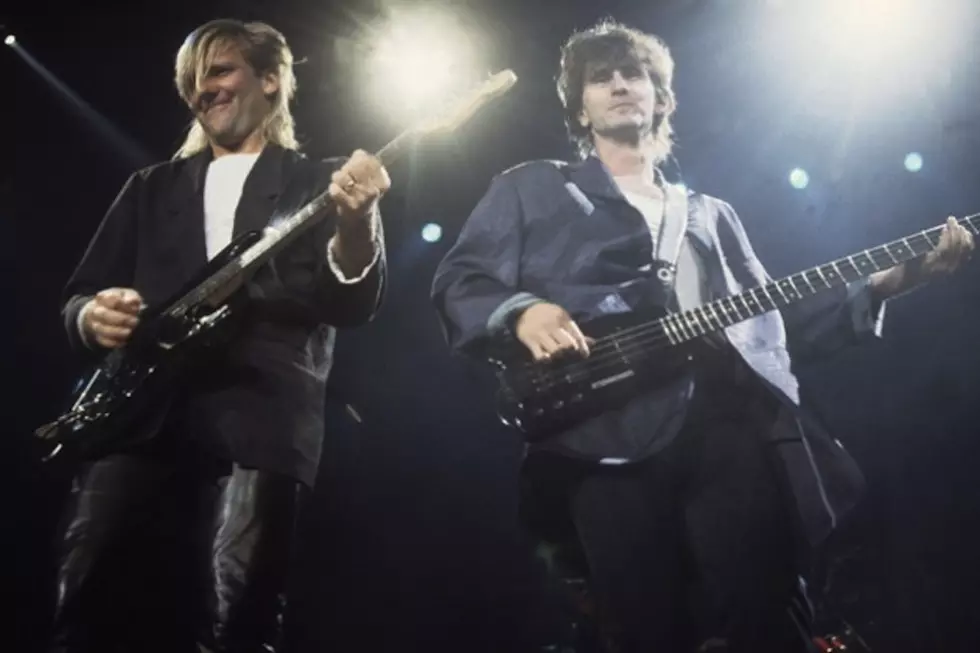
When Rush Closed Out the ’80s With the Transitional ‘Presto’
Judging solely in superficial terms, 1989's Presto is a minor offering in Rush's massive discography. Released in a wasteland of rock production, the album's indistinct sonic vibe falls somewhere between Rush's synth-driven early '80s era and their guitar-heavy return of the late '90s and early '00s. Then there's that hideous album cover, which features a levitating rabbit in a magic hat.
Those warning signs aren't totally irrelevant.: Years later, Presto feels a bit dated and tentative, inevitably paling compared to the band's masterpieces of a decade earlier. Even still, its best songs rank among Rush's most durable work, emphasizing tighter structures without sacrificing instrumental dexterity.
The creative atmosphere surrounding Presto was lethargic, at least initially. "I was the most concerned I'd ever been," Alex Lifeson told Music Express in 1990. "We'd just come off a tour, we were doing the live album A Show of Hands, and everybody was caught at a down point. There seemed to be an air of uncertainty as to whether we were properly motivated to record another album."
With that live LP, the trio – Lifeson, Geddy Lee and Neil Peart – had fulfilled their longtime contract with Phonogram Records. Without a deadline looming over their heads, they met up in December 1988 to gauge each other's interest in working on new material. And, as Lifeson told Music Express, their doubts quickly evaporated once they made a firm commitment to start writing.
"It was amazing how smoothly things went," he said. "Writing and recording albums is usually a tense, stressful period, but this one went amazing well. We were so well prepared that we had the album written, recorded and finished a month ahead of schedule, which for us is unbelievable."
One catalyst for that productive atmosphere was Peart's decision not to connect the songs in an overarching narrative or theme. This time out, the drummer-wordsmith – known for crafting fanciful sci-fi tales (1976's 2112) and apocalyptic snapshots (1984's Grace Under Pressure) – decided to write in a more relaxed style, with each song exploring its own topic. "There is no manifesto," Peart told Canadian Musician in 1990, "although there are many threads and a strong motif of looking at life today and trying to act inside it."
The album's lyrical centerpiece is its atmospheric single "The Pass," in which Peart addresses teenage isolation and the tragic romanticism of youth suicide. "All of us get lost in the darkness; dreamers learn to steer by the stars," Lee sings on the chorus, harmonizing with himself over a stabbing bassline and Lifeson's chiming guitars.
Listen to Rush Perform 'Superconductor'
Working for the first time with producer Rupert Hine, the band intended to strip away the mechanical, synth-driven gloss that defined their past few albums.
"I treated this new album in a very reactionary way," Lee told Guitar World. "I really wanted to get away from using so many keyboards and writing on the computer. I had immersed myself so totally in the world of MIDI that, as a matter of course, I was going to the keyboards to do all of my writing. And I found that there was something a little passive about the kinds of songs that were being written that way. So this time out, I wanted to do something that was more direct, more hard-hitting – something slightly more visceral."
Though the reverb and keyboard pads still give the LP an airy texture, tracks like 'War Paint' and 'Superconductor' do indeed pack a harder punch, driven by Lifeson's layered arpeggios and fills. Meanwhile, "Show Don't Tell" is as powerful a pure rock song the band had written since 1980's "The Spirit of Radio." Lee's funky bass is the focus, building to an emphatic chorus hook. The synths, meanwhile, are used for added texture, fleshing out the sound instead of driving it.
"We've probably gained a lot of new fans and lost some of our old ones with the last couple of releases," Lifeson told Music Express. "With Presto, I think we'll get some of the old ones back." And the fans – new or old – carried the album to gold status and a No. 16 spot on the Billboard album chart. "Show Don't Tell," meanwhile, topped the Mainstream Rock chart.
Despite the album's less glossy mix, Presto still plays like a period piece – from Peart's digital-tinged bass drum to the hammy backing vocals on "Superconductor" to the dorky sequenced synth-bass tone on "Scars." Regardless, the playing is as strong as ever: Peart's parts are less bombastic and showy, but never at the expense of power. The percussive highlight is "Scars," on which he blends a mix of acoustic and electronic drums into a towering tribal pattern that was inspired by a recent bicycle tour in Cameroon.
Though he'd always been one of the most acclaimed drummers of his generation, Peart told Modern Drummer that his confidence reached a new peak with on Presto. "I spent 20 years on technique and on learning the finer points of keeping good time, developing tempo and shadings of rhythmic feel, and keeping my mind open to other ethnic music and other drummers, and all of that was just flooding into me," he said in 1989. "When I finally became confident in my playing, all of these things finally came together. Confidence really was the key for me."
In a track-by-track comparison, Presto doesn't stack up with Rush classics like Moving Pictures or Hemispheres or A Farewell to Kings. Like most of their '80s work, it's equally endearing and awkward. But it also occupies its own place in the Rush discography, closing out the decade with chemistry and confidence intact.
The Most Awesome Live Album From Every Rock Legend
You Think You Know Rush?





